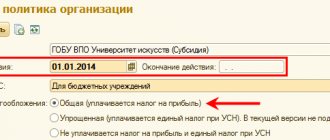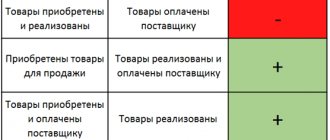Direct expenses in accounting in 1C 8.3
Direct expenses in accounting for 1C 8.3 will be those expenses that, when producing or providing services or carrying out work, will be taken into account as a debit to account 20 (23).
To reflect on the debit side of account 20 direct expenses for accounting in 1C 8.3, you need to set the parameters in the Accounting Policy, on the Costs tab:
It is necessary to indicate with a checkbox the types of activities for which the costs are planned to be taken into account on account 20. The checkbox is checked if direct production costs are taken into account for the production of products and the checkbox is checked for carrying out work and providing services to customers. The checkboxes are checked in order to keep or not keep records of direct expenses in the debit of account 20.
If this expense is direct according to the accounting policy of the organization, then in the transactions in 1C 8.3 you need to reflect the expense on the debit of account 20.
Construction
Very similar to production. A special feature is that construction materials are written off on the basis of estimates and calculations, and the closing documents are special KS forms. Very often foreign workers are involved in construction. In our opinion, construction is an even more labor-intensive activity than production, since the work requires a lot of raw materials, from nuts and screws to fittings and concrete slabs, and there are a lot of incoming documents for the purchase of materials.
Brief conclusion: The type of activity important influences the cost of accounting services, since each type of activity has its own specifics. A specialist, having heard what the company does, can immediately, based on experience and practice, determine the approximate workflow and difficulties that he will have to face when drawing up documentation and reports. Therefore, an accountant can easily estimate the cost of the work.
Direct expenses in tax accounting in 1C 8.3
Direct expenses in tax accounting are those expenses, the list of which is reflected in the Accounting Policy. In this case, the list of direct expenses must be specified in the Tax Accounting Policy. This is very important, because this list can be created independently, the Tax Code speaks about this.
To indicate the list of direct expenses in the 1C 8.3 database, there is a setting in the Accounting Policy, which is located in the menu - Accounting Policy item - Income Tax tab - hyperlink Methods for determining direct production costs in NU:
In 1C 8.3, the hyperlink “Methods for determining direct production costs in NU” determines the composition of direct costs for income tax:
What to do if an accountant finds it difficult to independently determine which direct expenses are in his organization was studied in detail at the Master Class “The whole truth about Income and Expenses”.
In tax accounting, there is no direct dependence on which account in the tax chart of accounts the posting is indicated on.
- The fact that the accounting system will be reflected in the debit of account 20, type of expense - Material expenses, will be a direct expense for the accounting system.
- If it is reflected in the debit of account 25, type of expense - Material expenses, this will also be a direct expense for NU.
The principle that if the count is 20, then this is only a direct expense for NU does not apply. The method that is added to “Methods for determining direct costs” is the method that will operate in 1C 8.3:
If for tax accounting expenses are taken into account in the debit of account 26, then in 1C 8.3 it is necessary to make a distribution of indirect expenses for account 26 “In the cost of products, works, services”:
Thus, account 26 is not written off at a time, but is distributed into account 20. This is convenient for those organizations that have decided to bring accounting and tax accounting closer together. When accounts 25 and 26 are distributed to the debit of account 20, that is, the full cost is calculated, it turns out that if account 26 is not defined as part of direct expenses, then the difference will be between accounting and tax accounting. This is normal, and this is what is expected by law.
Account 44 cannot be specified in “Methods for determining direct expenses”. Even if you add 44 accounts, the 1C 8.3 program will not define it as a direct expense. Also, if account 26 is added to the “Methods for determining direct expenses”, but in the Accounting Policy parameters the distribution of indirect expenses using the direct costing method is set, then account 26 will not be defined as a direct expense. Only if accounts 25 and 26 are distributed to the debit of account 20 and a list of direct expenses is specified, then everything will work in 1C 8.3.
ATTENTION TO DISTRIBUTION OF DIRECT AND INDIRECT COSTS
As is known, both direct and indirect expenses will ultimately reduce the tax base for profits. The only question is time. Indirect costs can be written off immediately. And to write off direct expenses, you will have to wait until the goods are sold (work performed or services provided), in the cost of which they are taken into account.
It is the difference in the time of recognition of expenses that causes disputes among accountants and auditors: which expenses can be classified as direct and which as indirect.
Direct expenses in the income tax return in 1C 8.3
To automate the process of correctly filling out a declaration in 1C 8.3 Accounting 3.0, it is important that the list of expenses is approved in accordance with the organization’s Accounting Policy.
In the Income Tax Declaration, direct expenses are reflected in Sheet 02 of Appendix 2, in lines 010, 020. It is for line 010 that the list of direct expenses is formed:
Those expenses that will be indicated in the “Methods for determining direct production costs in NU”, those expenses will be included in the income tax return. If the declaration is incorrectly formed, the calculation of income tax will be considered inconsistent with reality.
How to close account 20 in 1C 8.3
Let's consider whether in 1C 8.3 it is possible to implement automatic write-off of expenses from account 20 without taking into account revenue by item group.
A nomenclature group is a type of goods, works and services in 1C 8.3.
In the 1C 8.3 database there is a directory Nomenclature, where there is a group Products - these are the final products of the organization:
Or there is such a group as Services, which has its own services, that is, those services that are provided directly to customers:
In 1C 8.3 there is a directory Nomenclature groups. Many 1C 8.3 users are confused about what they are needed for. It seems that there is a nomenclature that is inserted into the documents for implementation. But in 1C 8.3 there are item groups for which analytical accounting is maintained on account credit 90, that is, both the item and the item group are added to revenue. The debit of account 20 is accumulated specifically according to the item group:
In the previous version of the 1C 8.2 program, until the revenue passes through the item group, account 20 will not be closed. For this reason, problems arose with closing account 20 in 1C, because for some services there could either be no revenue or, for example, sales are carried out according to one item group, and costs are reflected on two lines.
In order to avoid difficulties with closing account 20, 1C developers introduced a parameter in the Accounting Policy settings to close account 20 without taking into account revenue. This setting must be used for work or services:
Thus, in 1C 8.3 the Accounting Policy provides options for closing account 20 for works and services at the end of the month:
- Excluding revenue;
- Including revenue;
- Including revenue from production services only.
Method of closing account 20 “Excluding proceeds from work” in 1C 8.3
In 1C 8.3, this method makes it easier to work with 20 counts. If in 1C 8.3 it is difficult to maintain the dependence of account 20 on the credit of account 90 and item groups, then this method is the most acceptable, and account 20 will be closed monthly.
According to this method, the debit of account 20 will be closed if there is no revenue on the credit of account 90 or the revenue comes from another item group, provided that the Accounting Policy specifies the method of closing account 20 - “Without taking into account revenue from work.”
Thus, all costs recorded on account 20 for work and services will be written off automatically in full in Dt 90 always at the end of the month. Regardless of whether the proceeds from loan 90 are reflected or not reflected.
In order to reflect “work in progress” using this method, in 1C 8.3 you need to enter the document “Inventory of work in progress”, then the debit of account 20 will be closed minus the amount of “work in progress”:
Method of closing account 20 “Taking into account proceeds from work” in 1C 8.3
If in 1C 8.3 the option for setting up the Accounting Policy “Taking into account revenue from work” is selected, then
- If revenue is reflected for a product group, then the costs recorded on account 20 for the same product group will be written off automatically for the entire amount in DT 90 when closing the month.
- If there was no revenue for the product group, then the costs will not be written off, but will remain as work in progress in the debit of account 20.
Thus, strict compliance is necessary so that the debit of account 20 reflects the costs of one item group and the revenue necessarily goes through this item group. If there is no revenue for the item group in the current month, then account 20 will not be closed and will be transferred as “unfinished” to the next month.
Method of closing account 20 “Taking into account revenue only from production services” in 1C 8.3
Production services in 1C 8.3 are introduced using the document “Provision of production services”. In this method:
- Revenue from works and services should be reflected only using the document “Provision of production services”.
- If revenue is reflected by product group using this document, then the costs recorded on account 20 for the same product group will be written off automatically for the entire amount in DT 90.02 at the end of the month.
- If there was no revenue for the item group or it was entered in the document “Sales of goods and services,” then the costs will not be written off, but will remain in the form of work in progress in the debit of account 20.
Thus, if there is a debit to account 20 for a certain item group, then in order for it to be closed, revenue must be reflected for the same item group on the credit of account 90.01 using the document “Provision of production services.” You cannot use other documents for the sale of goods and services, otherwise the account will not be closed.
Setting up accounting policy parameters for direct expenses in 1C is discussed in more detail in the course on working in 1C 8.3 Accounting ed. 3.0.
Give your rating to this article: (
17 ratings, average: 3.76 out of 5)
Registered users have access to more than 300 video lessons on working in 1C: Accounting 8, 1C: ZUP
Registered users have access to more than 300 video lessons on working in 1C: Accounting 8, 1C: ZUP
I am already registered
After registering, you will receive a link to the specified address to watch more than 300 video lessons on working in 1C: Accounting 8, 1C: ZUP 8 (free)
By submitting this form, you agree to the Privacy Policy and consent to the processing of personal data
Login to your account
Forgot your password?







